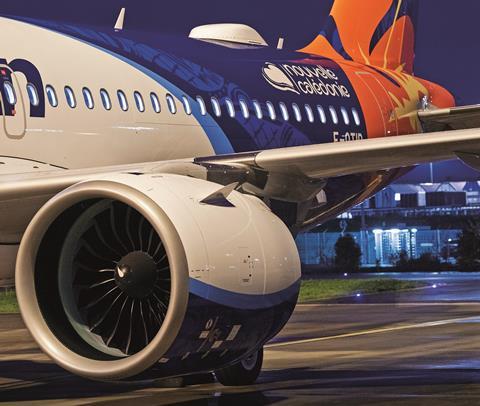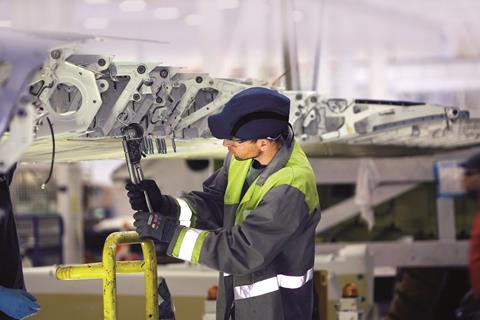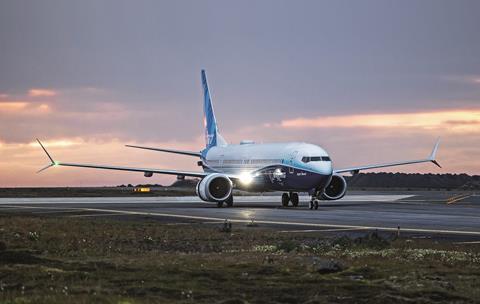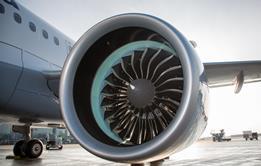Our latest Top 100 ranking of the biggest aerospace concerns is based on the first fully “normal” year since the pandemic, as airliners returned to the skies, Covid-19 restrictions on movement were lifted, and pent-up demand for air travel exploded. However, for much of the industry, 2022 was anything but back to business as usual.
The year began with Russia’s uninvited march into Ukraine, which sparked raw material shortages and energy price hikes around the world, as well as Western sanctions against the Putin regime. Inflation soared. Meanwhile, in North America and Europe airports and airlines – desperately understaffed after laying off experienced employees – struggled to cope with a busy summer.
LABOUR SHORTAGES
Those same labour shortages, coupled with snags in the global supply chain and rising prices, afflicted the manufacturing sector, which struggled to meet airframers’ ambitious ramp-up targets. This in turn led to late aircraft deliveries, undermining the fleet strategies of airline customers. MRO businesses were similarly stymied by lack of parts.

All these trends are reflected in this year’s figures, which show a revenue increase across the Top 100 of just 4.5% – weaker than some might have expected given 2022 was a “rebound” year with an inflationary surge. Sales growth among the biggest players was particularly sluggish, with the top 20 boosting revenues by just 3.4%. This compares with 13.4% for the smallest 20 ranked companies.
Profits (for the 67 businesses whose full financial information we have been able to source) rose 2.5%. This compares with 384% last time, although that was weighed against 2020 when aviation was grounded with the industry in crisis. Margins also tightened, to 7.8%, from 8.6% in last year’s survey, with operating profits at the biggest 10 businesses falling 4.7% to a total of $31.6 billion.
Thirteen of the businesses for which we have profit figures ended the financial year in the red. They include major names such as Boeing, Embraer, GKN Aerospace and Spirit AeroSystems. This compares with 12 last year, although that was based on just 63 entries where we were able to calculate operating profits.
Other significant trends thrown up by this year’s survey include sluggish defence sales generally, which has been reflected in the figures for some of the sector’s biggest primes. This might appear counter-intuitive during a year of rising international tensions. However, in 2022, political commitments to higher military spending had not yet fed through to payments to contractors.
Meanwhile, raw material companies show the strongest growth. This is perhaps less surprising as, of all the companies in the supply chain, these businesses had the whip hand at a time of severe shortages of metals and composites. Among those reporting the largest revenue increases in 2022 are metals specialists Arconic, ATI and Constellium.

There is a new look at the head of the Top 100, with Raytheon Technologies (now RTX), which combines Collins Aerospace and Pratt & Whitney with the legacy Raytheon defence businesses, securing the number one spot with revenues of $67.1 billion. Raytheon was placed second last time, and usurps Lockheed Martin, which has dropped to third on revenues slightly down on last time at $66 billion.
ROCKETING REVENUES
Boeing is battling to return to profitability, but saw revenues rocket $4 billion to $66.6 billion, although this is just two-thirds of its record $101 billion in 2018. Airbus, which topped the ranking three years ago (based on 2019 performance), is fourth with $61.8 billion sales, up slightly from $61.6 billion last time.
Airbus is one of several non-US companies whose results have been impacted by exchange rate movements in 2022. The European group enjoyed a 12.7% year-on-year revenue growth in euro terms – boosted by a stronger dollar, as most of its sales are in that currency. However, to keep the ranking consistent, we convert all financial results to dollars.
Elsewhere the shape of the top 20 is similar to the previous survey, except that German engine systems manufacturer MTU and US diversified component supplier TransDigm come in at 19 and 20, respectively, pushing South Korea’s Hanwha Aerospace and Japanese industrial group Mitsubishi further down the listing.
In fact, the whole Top 100 has a familiar feel with only two new entrants – or strictly speaking, returnees. Composite materials specialist Albany comes in at 93, propelled partly by its contribution to the fan blades on the in-demand CFM Leap engine, while engineering group ITT is also back, anchoring the ranking at 100.
CHANGING PLACES
They replace UK aerospace group Meggitt – ranked 44 last year, but now absent after its acquisition by Parker Hannifin in September 2022 for £6.3 billion ($8.1 billion at today’s exchange rate) – and Tusas Engine Industries, which we have removed as it is majority owned by Turkish Aerospace, which is listed in 45th place.
The “billion dollar club” – companies recording 10-figure revenues – starts this year in 61st place, two higher than last year. Last time, 59th placed Teledyne Technologies was the lowest-ranked company with sales over $1 billion. In the latest analysis, Taiwanese aerospace champion AIDC has that honour, with revenues of $1.01 billion.

Other than Parker’s absorption of Meggitt, the main merger and acquisition (M&A) story of 2022 was Montana Aerospace’s takeover in March of Belgian aerostructures firm Asco – which has appeared in the lower reaches of several previous rankings. The company had been a previous acquisition target of Spirit AeroSystems. That deal helped vault Swiss-based Montana 25 places to 73.
One significant divestment was that by Rolls-Royce of its Spanish unit ITP Aero to a consortium of investors led by Bain Capital Private Equity for €1.6 billion ($1.76 billion today) as part of a bid by the troubled UK propulsion giant to rebuild its balance sheet. Because the deal was approved towards the end of the year, it had a limited impact on Rolls-Royce’s 2022 results.
Two other businesses in the Top 100 changed hands, with space technology company Maxar ceasing trading on the New York Stock Exchange after its purchase by US private equity house Advent, whose portfolio also includes Cobham and defence electronics specialist Ultra in the UK. In December, Veritas Capital bought precision parts manufacturer Chromalloy – ranked 77 – from Carlyle for $1.6 billion.
M&A activity so far in 2023 is likely to affect next year’s table. Probably the most important move has been L3Harris’s swoop just before the end of 2022 for Aerojet Rocketdyne, ranked 37 in the Top 100, an all-cash transaction valued at $4.7 billion. Aerojet is the USA’s last independent producer of missile propulsion systems, including for Boeing’s lunar-return Space Launch System.
In late July this year, L3Harris confirmed that the US competition regulator would not be opposing the takeover. This was despite objections from Lockheed, whose own bid to buy Aerojet had been blocked by the Federal Trade Commission last year on the basis that it would have given Lockheed the ability to “cut off its competitors’ access to critical [missile propulsion] components”.
BUYING BIG
Meanwhile, Barnes Aerospace – 92 in the Top 100 – said in June it is to acquire MB Aerospace for around $740 million. MB, US-registered but based in Motherwell, Scotland, manufactures and repairs engine components and employs just under 1,500 staff in Poland, Taiwan, the UK and the USA. The transaction, the largest in Barnes’ history, is expected to close in the final quarter.
In May, Florida’s Heico agreed to acquire Wencor for just over $2 billion, which would also be that company’s most expensive purchase. Georgia-headquartered Wencor manufactures approved replacement parts. In July, Bombardier, which has spent much of the past six years divesting businesses, completed its takeover of Latecoere’s Queretaro, Mexico electrical wiring business.
The dismantlement of diversified UK aerospace and defence group Cobham since its $4 billion takeover in January 2020 by Advent continues. In July, Thales began negotiations to acquire Cobham Aerospace Communications, a maker of cockpit communication systems with revenues of around $200 million.
Cobham is listed 60th in this year’s ranking but has been dropping steadily down the rankings since 2019 as Advent sells off bits of the business, including its aerospace connectivity and mission systems units – it has divested eight since Cobham was delisted as a public company. The latest sale – for around $1.1 billion – will take the amount raised by Advent to around $7.2 billion.
POLE POSITION
M&A activity is “entering a strong upcycle after a quiet few years” as aircraft production rates ramp up and the supply chain issues that have hampered growth ease, argues Michael Richter, global head of aerospace and defence investment banking at Lazard Freres. “There’s no better time for M&A,” he says. “Aerospace companies are positioning themselves for the next wave of growth.”
With military spending on the up, consolidation will extend to the defence sector, says Richter, with the focus on mergers and acquisitions that will “improve vertical integration or alignment with broader [US] Department of Defense priorities”. He expects US investors to increasingly “look abroad for M&A targets”, particularly sub-$1 billion deals less likely to attract regulator scrutiny.
| Rank by growth | Rank by sales | Company name | Sales growth |
|---|---|---|---|
| 1 | 73 | Montana Aerospace | 123.3% |
| 2 | 67 | Constellium | 87.1% |
| 3 | 48 | Ametek | 76.2% |
| 4 | 55 | Panasonic Avionics | 68.5% |
| 5 | 44 | ATI | 65.4% |
| 6 | 91 | Recaro Aircraft Seating | 58.0% |
| 7 | 63 | Arconic | 52.0% |
| 8 | 66 | Aernnova | 45.8% |
| 9 | 87 | Latecoere | 39.4% |
| 10 | 34 | IHI | 37.3% |
| 11 | 93 | Albany Engineered Composites | 37.1% |
| 12 | 99 | Korean Air | 33.9% |
| 13 | 78 | Sonaca | 32.4% |
| 14 | 96 | Aciturri | 31.2% |
| 15 | 31 | Parker Hannifin | 30.8% |
| 16 | 69 | LISI | 28.5% |
| 17 | 61 | AIDC | 27.4% |
| 18 | 19 | MTU Aero Engines | 27.3% |
| 19 | 23 | Spirit AeroSystems | 27.2% |
| 20 | 80 | Subaru | 26.9% |
| Rank by margin | Rank by sales | Company name | Operating margin |
|---|---|---|---|
| 1 | 20 | TransDigm | 40.8% |
| 2 | 98 | Martin-Baker | 28.0% |
| 3 | 12 | Honeywell | 27.3% |
| 4 | 65 | Garmin | 26.9% |
| 5 | 33 | Eaton | 23.2% |
| 6 | 29 | Hindustan Aeronautics | 22.7% |
| 7 | 58 | Teledyne Technologies | 20.4% |
| 8 | 7 | GE Aerospace | 18.3% |
| 9 | 74 | Crane Aerospace and Electronics | 18.0% |
| 10 | 75 | RUAG | 18.0% |
| 11 | 92 | Barnes Aerospace | 17.8% |
| 12 | 52 | Triumph Group | 17.3% |
| 13 | 51 | Pilatus | 16.8% |
| 14 | 56 | Kongsberg | 16.2% |
| 15 | 31 | Parker Hannifin | 15.7% |
| 16 | 49 | Woodward | 15.2% |
| 17 | 16 | General Dynamics (Aerospace) | 13.2% |
| 18 | 3 | Lockheed Martin | 12.7% |
| 19 | 32 | CAE | 11.6% |
| 20 | 66 | Aernnova | 11.4% |
| Rank | Manufacturer | 2022 sales $ millions | Sales growth |
|---|---|---|---|
| 1 | Airbus | 43,563 | 14.6% |
| 2 | Boeing | 25,867 | 32.7% |
| 3 | Embraer | 1,544 | 17.3% |
| 4 | ATR | 896 | 20.5% |
| 5 | Gulfstream | 8,567 | 5.3% |
| 6 | Bombardier | 6,853 | 14.3% |
| 7 | Textron Aviation (including military sales) | 5,073 | 11.1% |
| 8 | Dassault Aviation | 2,212 | 7.8% |
| 9 | Embraer | 1,244 | 10.1% |
| Rank | Company name | Defence sales $ million | Defence sales growth |
|---|---|---|---|
| 1 | Lockheed Martin | 65,446 | -1.7% |
| 2 | Raytheon Technologies (RTX) | 39,686 | -4.9% |
| 3 | Northrop Grumman | 36,602 | 2.6% |
| 4 | Boeing | 23,162 | -12.7% |
| 5 | Rostec State Corporation | 16,525 | -1.5% |
| 6 | L3Harris | 16,370 | -3.3% |
| 7 | BAE Systems | 13,169 | -10.7% |
| 8 | Leonardo | 12,841 | -7.4% |
| 9 | Airbus | 11,839 | -1.7% |
| 10 | Dassault Aviation | 5,074 | -18.7% |
The Top 100 is compiled on behalf of FlightGlobal by Counterpoint Market Intelligence.
Supporting documents
Click link to download and view these filesTop 100 aerospace companies by revenue 2022
PDF, Size 72.65 kb
Top 100 aerospace companies ranked by revenue

The past financial year was one of post-pandemic recovery for many of the largest aerospace companies. However, supply chain woes and a depressed defence sector were a brake on growth.
 Currently
reading
Currently
reading
Top 100 aerospace companies ranked by revenue
- 2
- 3
- 4
- 5



































